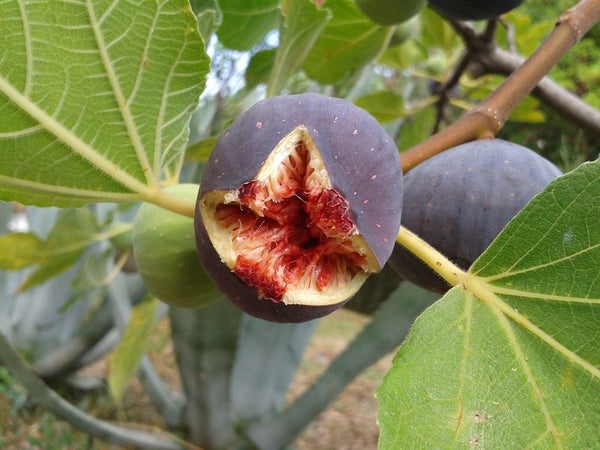So, the fig is on our fruit radar. With figs rising in popularity, we thought we’d outline a few of the benefits of this must-have fruit. They’re easy to grow, and used in a large variety of different recipes. Let’s get figgy with it and learn all about them!
Figs: A History
Fig Trees have been around for a very long time. In fact, they were one of the earliest domesticated plants. They originated in Western Asia and the Middle East, with evidence of domestication around 10,500 to 11,700 years ago. Thousands of years to practice growing figs means more than 1,000 different varieties exist today. As people spread to new areas of the world, so did figs. Romans enjoyed figs, and later in the 1600s, so did Londoners.
Figs and fig trees developed over the years, are tied into a few different religions and are even sacred in some cultures. Apollo had a cow get tempted by a fig tree on its way to collect water, Buddha supposedly have found enlightenment under a fig tree, Muhammad suggests that figs were from paradise, and Adam and Eve apparently used fig tree leaves to cover themselves. That’s a lot of different cultures that mention figs.

Types of Fig Trees
The Brown Turkey Fig Tree, which is one of the oldest and most reliable fig varieties, is recommended for growing zones 7 through 10 and can get quite large: 10 to 25 feet tall and 12 to 15 feet wide. However, these trees also do excellent in containers. Brown Turkeys aren’t ripe until they fully turn from a green color to a reddish rusty brown color with a purple hue. The flesh inside is a rosy red color, and it tastes very sweet, with a nutty flavor similar to hazelnut. You’ll get figs from this tree twice a year, once in the spring and a second time in the fall.
One very cold hardy fig tree is the Chicago Hardy Fig Tree. It’s recommended for growing zones 5 through 10 and can survive below-freezing temperatures. It grows to between 15 to 30 feet tall and 15 to 30 feet wide. This tree also does very well in containers. The Chicago Hardy Fig is ripe when it turns a dark purple color – its flesh is a deep red color and they taste very sweet.
Last but not least, the Celestial Fig Tree, nicknamed the ‘sugar fig’, produces a very sweet fig. These figs have light purple skin when they’re ripe and light pink to amber flesh. The Celestial is recommended for growing zones 7 through 11. Also, this fig tree is cold hardy down to 10 degrees. However, it’s another variety that grows smaller than the rest, growing to about 5 to 10 feet tall and 5 to 10 feet wide. Keep it in the ground or a container, and you’ll get figs in the late spring and early fall.
Care
First, select an area for your fig tree that receives full to partial sunlight. Fig trees love all the sun they can get but will do fine in partial shade. If it’s kept indoors, it should be placed by a large, sunny window. Placing your tree in a plastic pot will keep it lighter, so you can move your tree indoors and outdoors.
Fig trees are used to drier climates and don’t like to be overwatered. Check on your fig tree once a week, and give it water if the soil is dry to the touch, down about one inch. If your fig tree is in a container, make sure that it has holes in the bottom so extra water can drain out. Your soil should be well-draining. Generally, fig trees don’t need any fertilizer, but they may need a boost if they’re growing slowly or have pale leaves.

You can fertilize your fig trees with a well-balanced formula, like 8-8-8 or 10-10-10. It will be best to break up the recommended fertilizer dosage for the size of your tree into thirds, and spread out dosage over three months during summer. Over-fertilization can cause fig trees to prematurely drop their fruit before it’s ripe.
The fruit only ripens on the tree, so don’t pick it prematurely. Wait for them to reach their mature color, whether it’s a rusty brown color or light purple. Ripe figs will have a bend in their necks and feel soft to the touch. If your figs are still green or firm to the touch, leave them on the tree and check on them again in a few days.
Benefits
Eating a fresh fig is a rewarding experience. They’re soft and sweet, while their skin is chewy, and their small seeds provide a small crunch. You don’t have to peel or prep them; you can eat them right off the tree. Dried figs are really healthy for people as well.
Figs are full of potassium, so they make an excellent banana alternative. Potassium is good for your bones, brain, heart, and muscles. Furthermore, doctors even say that potassium can lower your blood pressure. Antioxidants are also found in figs, meaning they can give your skin and health a boost.
If you need fiber, grab a fig. Fiber can make you feel fuller, so snacks with more fiber can lead to weight loss because people will be eating less.
Fiber can boost your energy too! Plus, figs contain B vitamins which can boost energy as well. If you put a diced fig in a morning smoothie or your cereal, you may not need a cup of coffee. You’ll be full of natural energy. Check out our array of fig trees to get your own!





